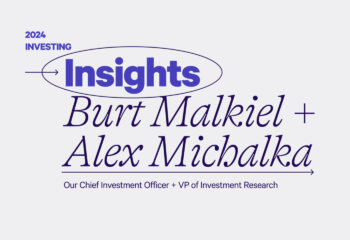A recession, commonly defined as two quarters in a row of shrinking gross domestic product (GDP), is generally considered bad news. Recessions cause real suffering, especially through rising unemployment and general financial uncertainty—so it’s normal to feel concerned about an economic slowdown and the impact it could have on you and your loved ones. But unemployment aside, if you’re a young investor with a diversified portfolio and a long time horizon, you don’t need to be too worried about the impact a recession will have on your long-term wealth-building. In fact, a recession could actually work in your favor.
In this post, I’ll walk through why investors can find a silver lining in a recession and provide some tips for protecting your wealth during economic downturns.
Recessions are common and temporary
According to the National Bureau of Economic Research (NBER), there have been 34 recessions since 1854, including the 2020 recession. Using NBER’s definition, this translates to a recession every 4.94 years on average. It’s worth noting that the NBER defines a recession as a “significant decline in economic activity” that lasts for “more than a few months”—not necessarily two consecutive quarters. The takeaway? Even if this is your first recession, it’s probably not your last.
Fortunately, even though recessions are common, they’re not permanent. To date, every single recession in the US has recovered eventually. According to NBER research, recessions between 1945 and 2009 only lasted about 11 months on average. That’s not very long, especially if you’re investing for the long run.
You can benefit from investing in a recession
You get to buy investments at a discount
Let’s imagine you have a favorite breakfast cereal, and you buy a box of it every week or so at the grocery store. If that cereal went on sale for a few weeks or even months, odds are you’d be happy about it.
This makes intuitive sense, but investors sometimes have trouble applying the same logic to stocks when they’re on sale. In a recession, the stock market will usually decline sharply —on average, the S&P 500 has dropped about 29%. But if you believe that the market will rebound eventually (and historically, it has) you can look at stocks as being on sale, just like your favorite breakfast cereal in the example above. Using this logic, it’s a good thing when the market is temporarily down and you can buy investments at more reasonable prices.
You can even come out ahead when you invest in a declining market compared to investing a steadily rising one. To take advantage of this, you can use dollar-cost averaging (a strategy that involves investing a set amount of money on a schedule, like $100 a week or $500 per month). That way, you don’t have to worry about picking the “right time” to invest—you’ll just buy investments at a range of prices over time, and during a recession, some of those prices are bound to be lower.
You can harvest losses to lower your tax bill
It’s not fun to watch your portfolio temporarily decline in value, but there’s a silver lining: tax-loss harvesting. When the value of an investment dips below its purchase price, you can sell it at a loss and replace it with a similar investment. This allows you to “harvest” the loss and maintain the overall risk and return characteristics of your portfolio. Come tax time, you can use that loss to lower your tax bill.
Done manually, tax-loss harvesting can be labor-intensive. But Wealthfront’s Tax-Loss Harvesting handles the process automatically and at no extra cost. Clients who started using our Tax-Loss Harvesting last year received tax savings worth between 4 and 9 times our advisory fee in 2021.
How investors can prepare for a recession
Make sure you have a good emergency fund in a high-yield cash account
Recessions often mean higher unemployment, so they’re a good time to make sure you have an adequate emergency fund. For most people, this means holding enough cash in reserve to cover 3-6 months’ worth of living expenses. The right amount for your specific situation will depend on your age, profession, investable assets, and your extended family’s financial needs. It’s wise to hold your emergency fund in a high-yield account like the Wealthfront Cash Account—with a 5.00% APY through our partner banks, no market risk, and 32 times the FDIC insurance offered by a traditional bank account, it’s a safe place for your emergency savings to grow until you’re ready to invest.
Having a good emergency fund can give you some peace of mind. If you’re concerned you might be affected by layoffs, you’ll probably sleep better at night knowing you have enough cash to cover your bills until you find a new job.
If you do experience job loss or wage loss, we also recommend that you cut your spending (which will help your emergency fund last longer) and ask your service providers about any payment extensions they may be able to offer.
Stay invested, even if your investments are down
No one likes logging into their brokerage account and seeing that their portfolio is worth less today than it was yesterday, but in a recession, this is bound to happen. Some investors will even feel tempted to liquidate their account in an attempt to minimize further losses. If this sounds like you, consider checking your portfolio less often until the market stabilizes. This strategy won’t change what’s happening to your portfolio, but it will make it easier for you to stay the course, which is key to long-term investing success.
Make sure your investments are diversified
Diversification, or the practice of buying different types of investments to improve your risk-adjusted returns, is especially important in a recession. Different asset classes will fare differently when the economy slows down, and you’ll be better insulated from losses if you don’t put all your eggs in one basket. If you feel insulated from losses, it’s emotionally easier to stay in the market.
You might see news articles about doubling down on certain asset classes or sectors during a recession. But if you have a diversified portfolio built to weather all market conditions like Wealthfront’s Classic, Socially Responsible, or Direct Indexing portfolios, you’re already set: these portfolios are globally diversified across a range of asset classes (unlike, say, just investing in a US stocks index fund). Remember that adjusting your asset allocation in response to market conditions is a form of market timing—and unfortunately, academic research has consistently shown that this doesn’t work.
The bottom line
Recessions are uncomfortable, but they’re a normal part of long-term investing. They’ve always recovered eventually, and can even be good for investors. Assuming there’s no major change in your financial situation like job loss or supporting a family member (in which case you might need to slow down the rate at which you’re putting money in the market), stick to your investing plan and try to ignore the headlines. If you keep rebalancing your portfolio, harvesting your losses, and making regular deposits, you’re likely to come out ahead in the long run.
Disclosure
The information contained in this communication is provided for general informational purposes only, and should not be construed as investment or tax advice. Nothing in this communication should be construed as a solicitation, offer, or recommendation, to buy or sell any security. Any links provided to other server sites are offered as a matter of convenience and are not intended to imply that Wealthfront Advisers or its affiliates endorses, sponsors, promotes and/or is affiliated with the owners of or participants in those sites, or endorses any information contained on those sites, unless expressly stated otherwise.
Investment management and advisory services–which are not FDIC insured–are provided by Wealthfront Advisers LLC (“Wealthfront Advisers”), an SEC-registered investment adviser, and financial planning tools are provided by Wealthfront Software LLC (“Wealthfront”). Brokerage products and services are offered by Wealthfront Brokerage LLC, member FINRA / SIPC. All investing involves risk, including the possible loss of money you invest, and past performance does not guarantee future performance. Please see our Full Disclosure for important details.
Wealthfront Advisers, Wealthfront Brokerage and Wealthfront are wholly owned subsidiaries of Wealthfront Corporation.
Copyright 2022 Wealthfront Corporation. All rights reserved.
About the author(s)
Alan is Wealthfront’s Chief Financial Officer and holds a CFA (Chartered Financial Analyst) charter as well as a Series 27 license from FINRA. Prior to Wealthfront, he worked at Crowe Horwath and KPMG. View all posts by Alan Imberman, CFA



